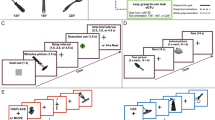Abstract
We used positron emission tomography (PET) to measure movement set-related changes in regional cerebral blood flow (rCBF) when human subjects were asked to copy hand movements. Movement set-related activity in the brain is thought to reflect the processes of movement selection, preparation and inhibition. Four conditions were used. In the first condition, prepare and execute (PE), the hand stimulus to be copied was shown to subjects 3 s before an auditory “go”-cue instructed subjects to execute the movement; a large part of the scanning time was therefore spent in preparing to move. In the immediate execution condition (E), the hand stimulus and the go cue were presented simultaneously. The prepare-only condition (P) was similar to PE, except subjects only prepared to make the movement and did not actually execute any movement when they heard the auditory go-cue. The same stimuli were presented in a baseline condition (B), but the subjects were instructed to neither prepare nor execute movements. There were 5 principle findings: (1) In contrast to a previous study of human set-related activity in which movements were instructed by an arbitrary pattern of LEDs, preparing to make a copied movement causes rCBF changes in area 44 in posterior Broca’s area; (2) set-related activity can be recorded in the cerebellar hemispheres and midline; (3) we confirmed that the supramarginal gyrus has a general role in preparing movements – there was more rCBF in the P than the E condition; (4) the cerebellar nuclei and the basal ganglia may be particularly involved in the initiation and execution of a planned movement; these regions were more active in the PE condition than the P condition; (5) the ventrolateral prefrontal cortex and a left anterior cingulate area are part of a distributed system involved in the suppression of a motor response; these areas were significantly more active in the P than the PE condition.
Similar content being viewed by others
Author information
Authors and Affiliations
Additional information
Received: 15 July 1996 / Accepted: 3 July 1997
Rights and permissions
About this article
Cite this article
Krams, M., Rushworth, M., Deiber, MP. et al. The preparation, execution and suppression of copied movements in the human brain. Exp Brain Res 120, 386–398 (1998). https://doi.org/10.1007/s002210050412
Issue Date:
DOI: https://doi.org/10.1007/s002210050412




